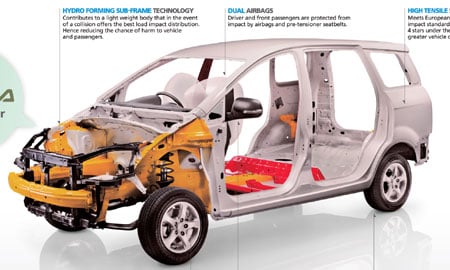This is the latest and probably one of the most final in a series of teaser images released by Proton of the Proton Exora 7-seater MPV. If you visited the Proton Technology Week they held sometime back you would have already seen this in real life, but this version shows some of the different metals used in the structure.
The single-piece front end module is made of plastic (but reinforced by metal in some areas) and the front subframe uses a hydroformed sub-frame technology that contributes to helping the Exora lose a few KGs, which means the CamPro CPS will have less to lug around. Being a single piece, it will be easier for the assembly line workers to install the front end module.
This is how part design can affect quality – other than the actual quality of the component itself, if a component is easier to install there is a higher chance for the assembly line works to always get it right the first time around.
UPDATE: To learn more about the benefits of a hydroformed front subframe, check out this link by Subaru. Thanks to reader Fridz.
Read our previous detailed coverage on the Exora:
Related Posts:
Proton Exora set for 15th April 2009 launch
Proton Exora Prototype Test Drive Experience
Proton Exora MPV: Body Control Module and more juicy details
Proton Exora features list teaser scan
Proton Exora MPV meter panel and dashboard textures in high resolution
Proton Exora MPV teaser scans: flat-folding seats
Proton Exora 7-seater MPV interior details revealed
AD: Drive the Proton model of your dreams. Submit your details and Proton PJ will get in touch with you.
Looking to sell your car? Sell it with Carro.





















AI-generated Summary ✨
The comments express a mix of excitement, anticipation, and skepticism about the Proton Exora. Many are eager for its launch, with some sharing leaked photos and speculations, while others question its safety ratings, build quality, and design, comparing it to other MPVs like Livina, Livina, Wish, and Stream. There are concerns about the long teaser campaign, the use of parts such as hydroformed subframes, and safety features like airbags, NCAP ratings, and crash testing. Some appreciate Proton’s efforts in improving quality and safety, citing its engineering strategies and competitive pricing, especially in the context of the local market and economic conditions. Overall, sentiments are cautiously optimistic but critically analyzing whether Proton can deliver a reliable, safe, and well-priced family MPV.